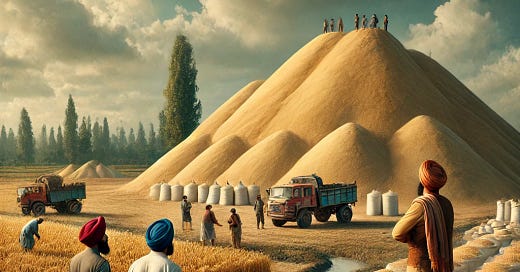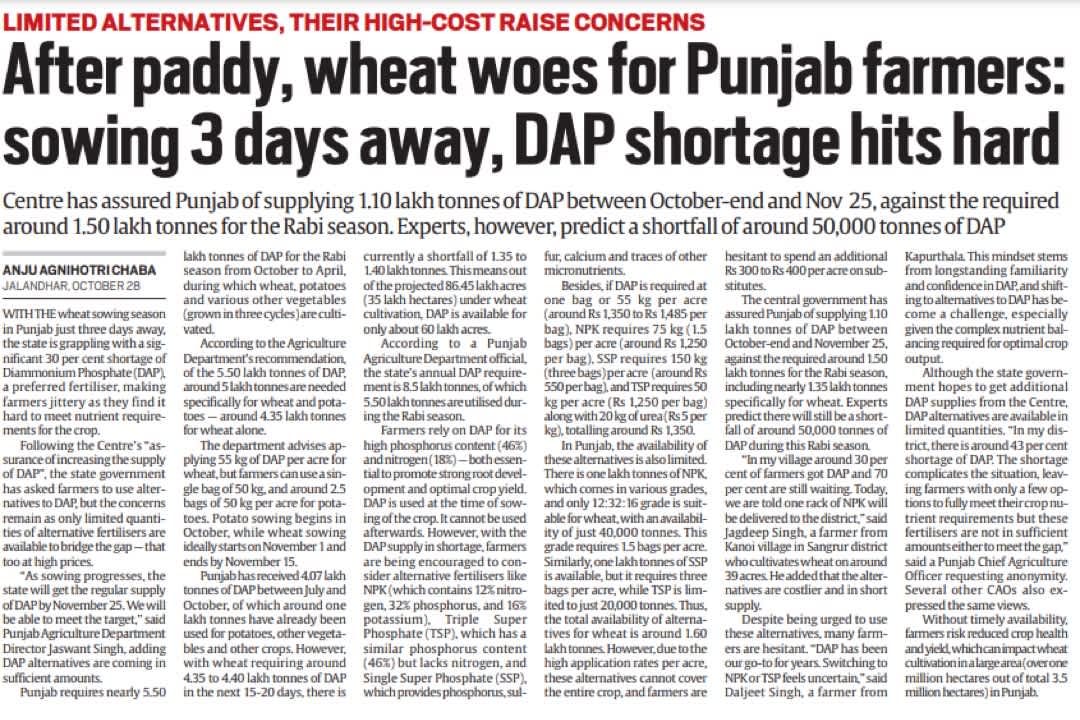Double Whammy for Punjab Farmers: Unsold Paddy and DAP Fertilizer Shortage
While policymakers debate, Punjab’s farmers face urgent challenges that jeopardise their productivity, incomes, and future, underscoring need for comprehensive short-, medium-, and long-term solutions
Double Whammy for Punjab Farmers
Farmers in Punjab and Haryana are grappling with a pressing double crisis: unsold paddy stocks and a severe shortage of Diammonium Phosphate (DAP) fertiliser, indispensable for the upcoming wheat sowing season starting on 1st November. This shortage not only endangers wheat cultivation—an essential crop in the nation's food security framework—but also underscores the government's failure to adequately plan and allocate resources, leaving farmers in an increasingly precarious situation.
Essential Role of DAP Fertiliser in Wheat Cultivation and Punjab’s Critical Shortage
Diammonium Phosphate (DAP) fertiliser is vital for wheat cultivation, particularly due to its high phosphorus content (46%), which supports robust root growth, early plant development, and overall crop vitality. With its unique blend of phosphorus and nitrogen, DAP is highly effective for wheat, especially in early stages where strong root systems are crucial to navigating varied soil conditions and achieving optimal yields.
As Punjab gears up for the Rabi season, it faces a severe DAP shortage that threatens wheat production on a large scale. The state requires around 5.50 lakh tonnes of DAP to support critical crops like wheat, potatoes, and other vegetables. Wheat alone, which covers approximately 35 lakh hectares, needs about 4.35 lakh tonnes of DAP. However, a looming shortfall of 1.35 to 1.40 lakh tonnes persists, with current supplies sufficient for only about 60 lakh acres. Despite the central government’s promise to deliver 1.10 lakh tonnes by 25th November, experts predict a continuing 50,000-tonne deficit.
This shortage is further exacerbated by Punjab farmers’ heavy reliance on DAP, which they favour for its essential role in establishing resilient root systems. While alternatives like NPK and SSP exist, these are generally less effective and less widely accepted by farmers accustomed to DAP’s proven benefits, underscoring the urgent need to address this supply gap.
Unmet Demand and State-Wise Allocation Inequities
The severe shortfall in DAP supply has hit Punjab’s farming community hard, with the state receiving barely half of its projected fertiliser requirements to date. Haryana faces a similar crisis, exacerbated by reports that significant portions of DAP allocations are being diverted to politically strategic, poll-bound areas. This uneven distribution has fuelled black market activity, forcing farmers to buy fertiliser at steeply inflated prices from private vendors. Such actions reveal a troubling prioritisation of political gain over agricultural needs, further alienating the farming community, particularly in India’s wheat bowl states, where timely access to DAP is critical for successful crop cycles.
Domestic Production Limitations and Supply Chain Vulnerabilities
India’s annual DAP consumption stands at approximately 10.5-11 million tonnes, while domestic production meets only 4-5 million tonnes of this demand. Key producers like IFFCO, Paradeep Phosphates Limited (PPL), and Gujarat State Fertilizers & Chemicals Limited (GSFC) operate within constrained capacities:
IFFCO: Produces 1.92 million tonnes annually.
PPL: Produces 0.64 million tonnes annually.
GSFC: Produces 0.57 million tonnes annually.
These companies face substantial production constraints due to limited access to essential raw materials like rock phosphate and sulphur, the majority of which are imported from countries such as Jordan, Morocco, Egypt, and Saudi Arabia. This dependency on international suppliers makes India’s DAP supply chain highly susceptible to external disruptions, price fluctuations, and geopolitical tensions, further intensifying the challenge of meeting the country's fertiliser needs.
Growing Demand and Production Constraints
Domestic production of DAP has been outpaced by rising demand, particularly as irrigation improvements have expanded cultivable land in states like Madhya Pradesh and Maharashtra. However, raw material availability remains a major bottleneck in meeting this demand. This mismatch highlights a critical oversight in expanding fertiliser capacity to parallel India’s growing agricultural requirements, which affects both immediate and long-term food security.
Global Market Pressures and the “Food vs. Fuel” Dilemma
International market dynamics have intensified India’s DAP shortage, with export restrictions from countries like China exacerbating the global supply crunch. China, in particular, has redirected phosphoric acid—crucial for DAP production—toward its burgeoning electric vehicle (EV) battery industry, driving up prices and limiting availability. This shift has sparked what some newspapers are calling a “food vs. fuel” debate, as essential agricultural inputs are diverted for industrial use. These developments highlight the vulnerability of India’s agricultural sector to global market volatility, underscoring the urgent need for strategic domestic policies to shield farmers from such external pressures.
Fiscal Implications of DAP Imports
India's growing dependence on DAP imports to bridge domestic shortages is poised to impose a heavy and unsustainable fiscal strain on the nation. Imported fertilisers are not only substantially more expensive than those produced domestically, but they are often of inferior quality, undermining their effectiveness in critical crop cycles. With fertiliser subsidies already accounting for nearly 24% of the agricultural budget, unchecked imports would inflate the subsidy bill to levels that could seriously compromise fiscal responsibility.
The current subsidy framework, which provides a base subsidy per tonne of DAP, places a significant burden on the national exchequer—one that is only worsening as global prices climb. As the financial load mounts, the government will find it increasingly difficult to keep fertiliser prices within reach for farmers, raising serious concerns about the long-term sustainability of such subsidies. In the absence of a well-planned domestic production strategy, the reliance on imports threatens not only fiscal stability but also the viability of affordable agricultural inputs for India’s farmers.
PM-KISAN Scheme: Support Amid Growing Frustration
The Pradhan Mantri Kisan Samman Nidhi (PM-KISAN) scheme aims to support India’s farmers by providing ₹6,000 annually to eligible farmers in three instalments. With an annual allocation of ₹60,000 crore, this scheme assists over 11 crore farmers in supplementing their income for agricultural inputs and meeting household expenses. However, the goodwill generated by such financial support risks being overshadowed by the immediate challenges farmers face, including unsold paddy in mandis and the acute shortage of crucial fertilisers like DAP. These pressing issues, if left unaddressed, could erode the intended benefits of PM-KISAN, leaving farmers increasingly frustrated and financially strained.
Political Calculations and Strategic Lapses
The politicisation of DAP allocation has sparked frustration and criticism, as reports of selective diversions to states preparing for elections deepen farmers’ disenchantment. These actions reflect a glaring lack of long-term planning, with decision-makers prioritising short-term electoral gains over stable and equitable resource distribution. Strategic foresight and agricultural stability are needed to avoid cyclical disruptions that erode farmers' livelihoods.
Summing Up: A Call for Accountability and Urgent Action
The ongoing crisis demands more than hollow promises and politically expedient gestures. It is time for a holistic, farmer-focused policy that prioritises the timely and adequate supply of DAP, grounded in the realities of agricultural need rather than short-term political optics. While policymakers continue to debate, Punjab’s farmers are left to grapple with immediate challenges that threaten their productivity, incomes, and future. Comprehensive solutions—short-term, medium-term, and long-term—are critical.
Punjab’s farmers, often maligned for growing water-intensive paddy, contribute the rice that enables Prime Minister Modi to provide food security to 80 crore Indians. Yet, the acute shortage of DAP for the upcoming wheat season reveals gross incompetence, verging on criminal negligence by those responsible for resource management. Without dedicated, strategic interventions to prevent such failures, we risk undermining the backbone of Punjab’s agrarian economy and perpetuating a system where farmers feel abandoned rather than valued. The time for genuine action is now.






"ਜਿੰਦ ਪੈ ਗਈ ਹੱਥ ਬਗਾਨੇ ਵੇ ਨਾ ਮਾਰ ਸੋਹਣਿਆ ਤਾਨੇ ਵੇ"
ਲੱਗਦਾ ਇਹ ਸਤਰਾਂ ਪੰਜਾਬ ਦੇ ਕਿਸਾਨਾਂ ਦੀ ਹਾਲਤ ਤੇ ਪੂਰੀਆਂ ਢੁਕਦੀਆਂ ਹਨ ਇਹਨਾਂ ਨੇ ਆਪਣੀ ਜਿੰਦ ਬੇਗਾਨੇ ਹੱਥਾਂ ਵਿੱਚ ਥਮਾ ਦਿੱਤੀ ਹੈ
……..who say Punjab is not being targeted, may understand now….